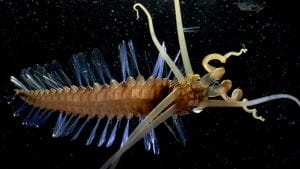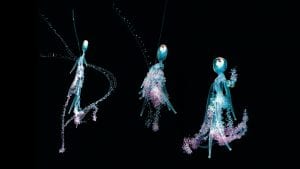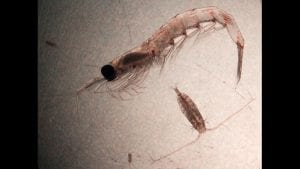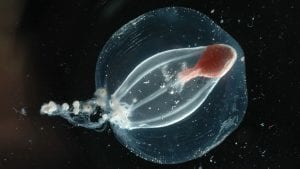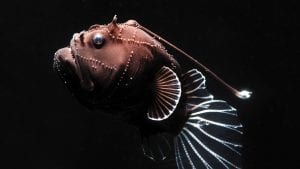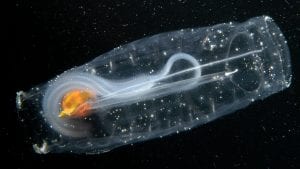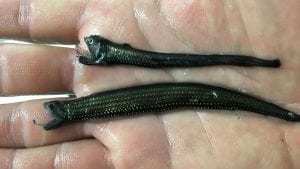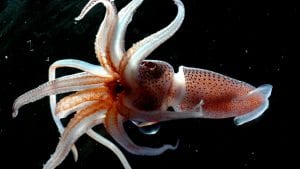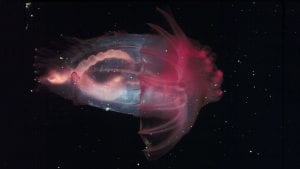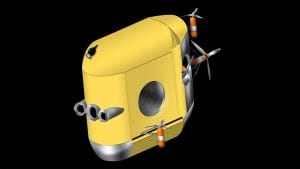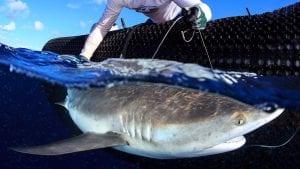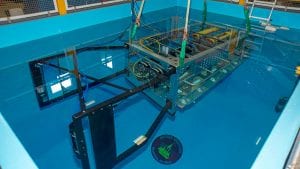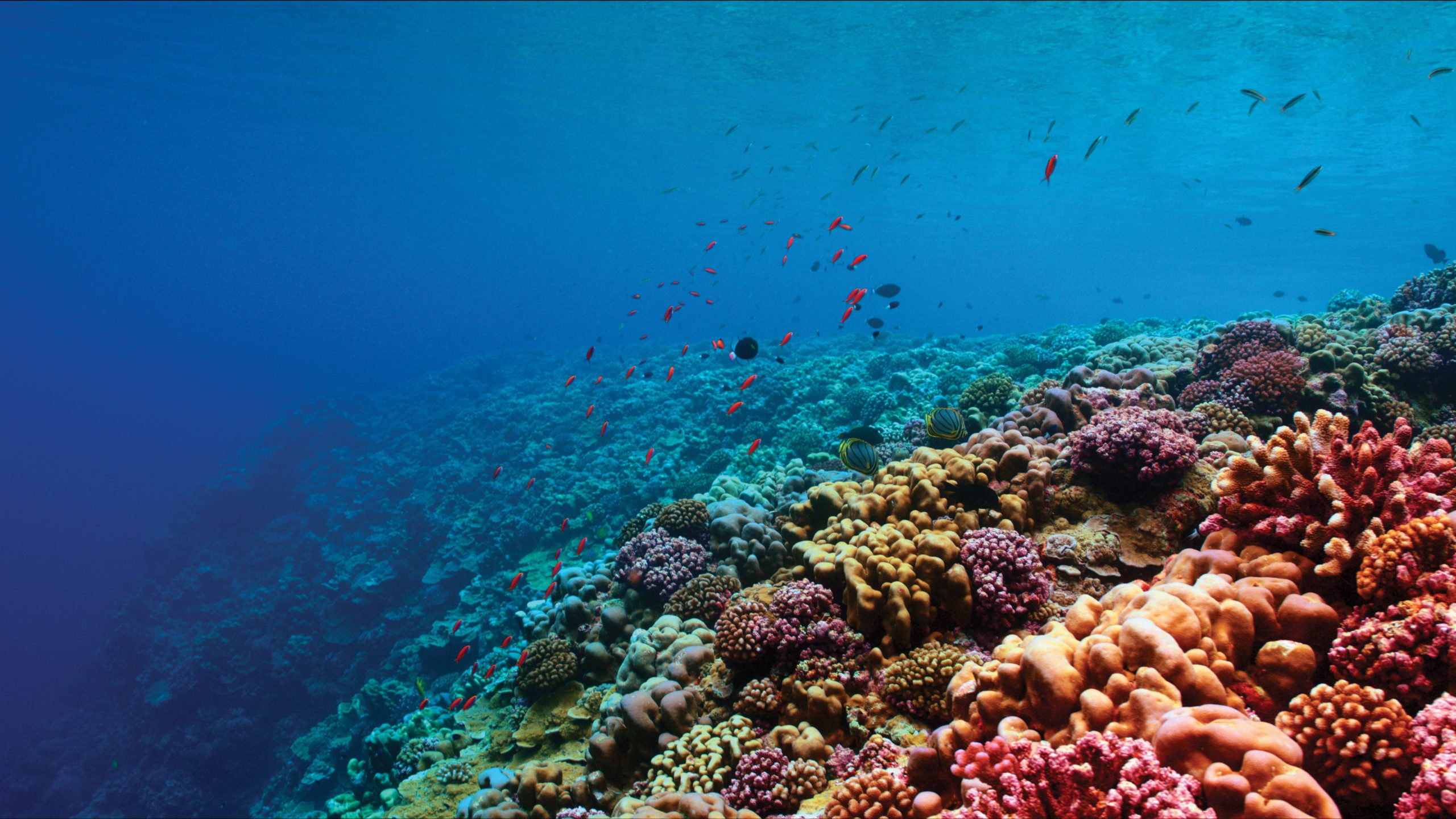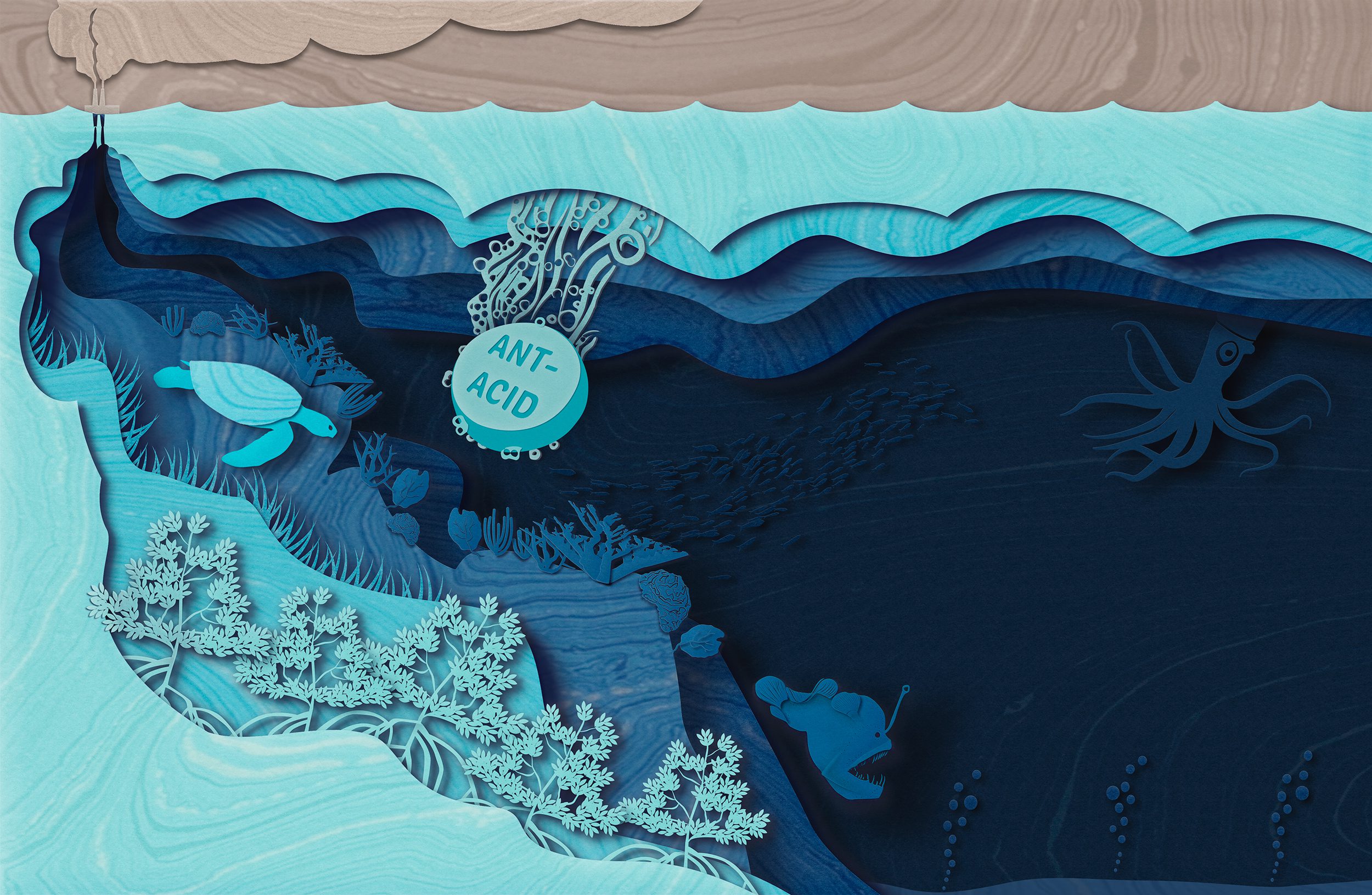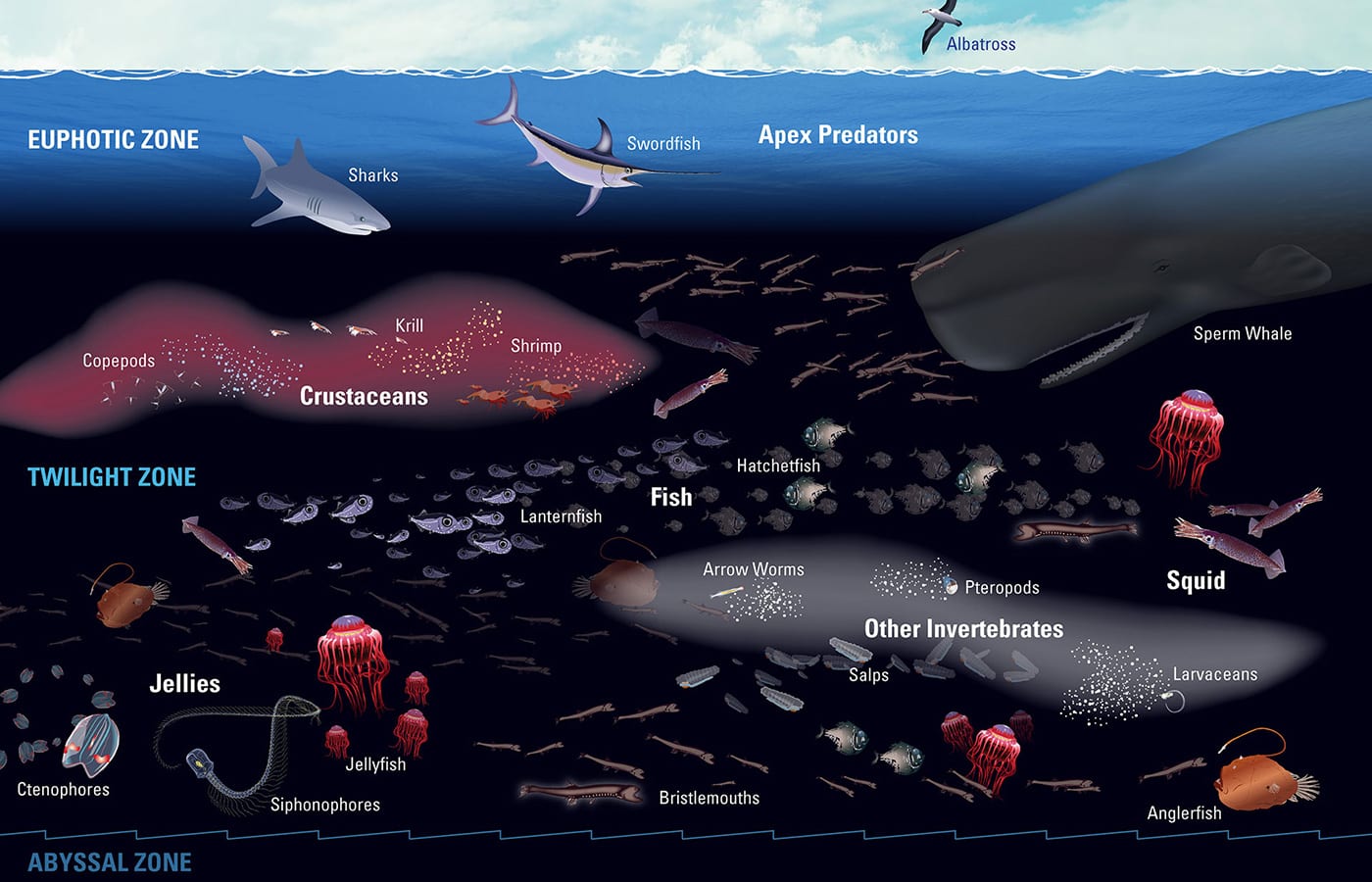
Mission to the Ocean Twilight Zone
The urgent quest to explore one of Earth's hidden frontiers
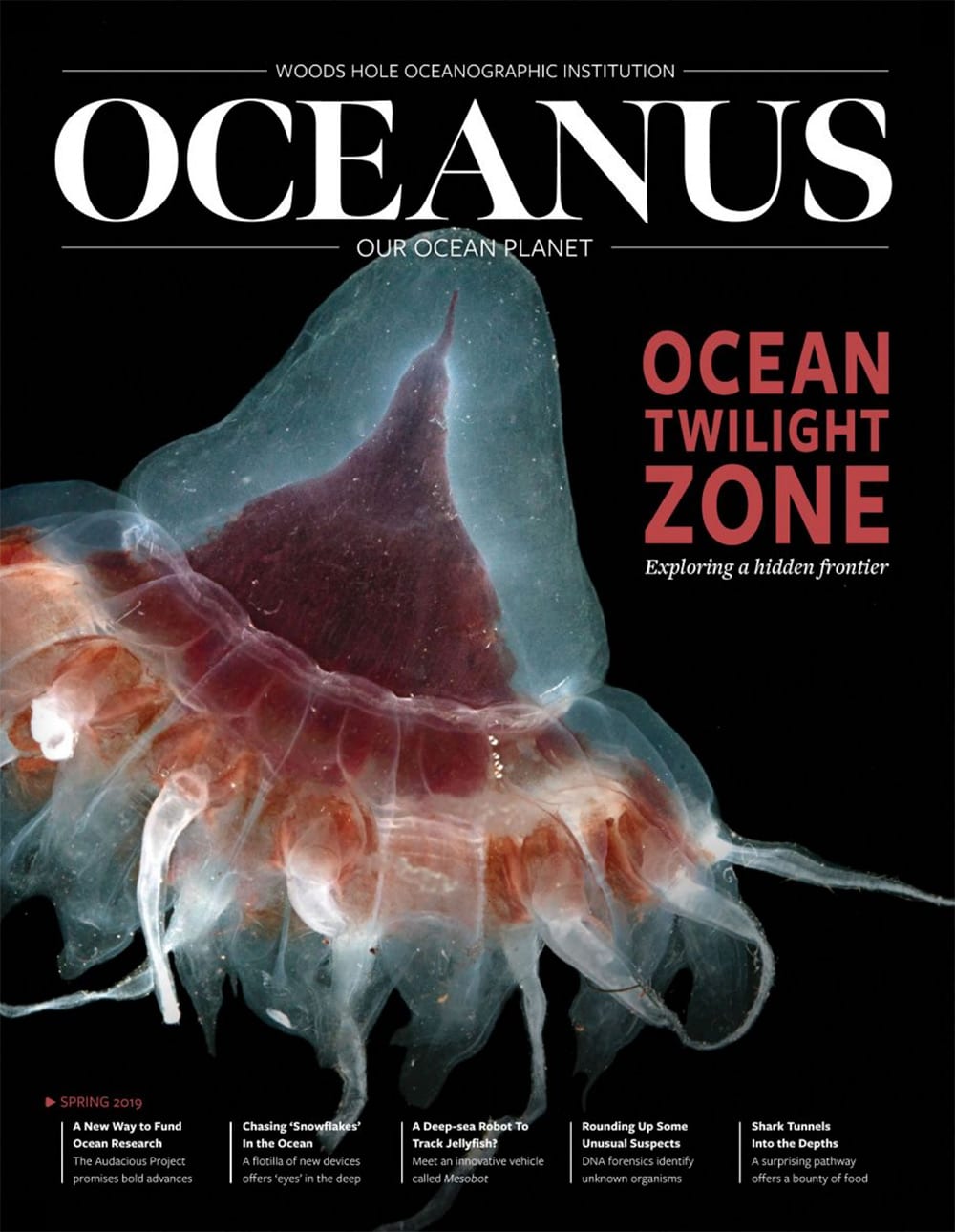 This article printed in Oceanus Spring 2019
This article printed in Oceanus Spring 2019
Estimated reading time: 21 minutes
Night falls over the open ocean. The sunlit blues and greens of its mercurial surface gradually fade to gray, then darken to inky black.
Hundreds of feet below, a multitude of fish, squid, plankton, and other mid-ocean dwellers begin their nightly passage up toward the surface to feed. By daybreak, they will be gone again, headed back to the relative safety of deeper, darker waters.
Theirs is the largest animal migration on the planet. It happens around the globe, every day, sweeping across the world’s oceans in a massive, living wave. The journey begins in the ocean’s mesopelagic region: a deep, cold, dimly lit twilight zone, 660 to 3,300 feet (200 to 1,000 meters) below the surface, where little sunlight penetrates.
The ocean twilight zone teems with life, from the microscopic to the gargantuan. Some animals migrate, others spend their lives in its shadowy depths. By eating and being eaten, they help support the ocean’s food web and transport huge amounts of carbon from surface waters into the deep ocean. That process, known as the biological pump, plays a critical role in regulating Earth’s climate.
The smorgasbord of twilight-zone creatures also attracts whales, tuna, swordfish, sharks, and other top predators that dive down hundreds or even thousands of feet to feed. And there’s plenty there for them to feast on: The biomass of fish alone may be more than in the rest of the ocean combined.
So far, the twilight zone’s rich biological resources have remained, for the most part, beyond the reach of commercial fishing nets. But some nations are gearing up to tap into its bounty—with unknown consequences for marine ecosystems and global climate.
For scientists, the immense, remote midwater region has proven difficult to study. It is exceedingly vast. It varies from place to place, and moment to moment. And many of the animals there avoid close-up observation or capture. As a result, the midwater remains poorly understood, relatively unexplored, and highly vulnerable.
Now, scientists and engineers at Woods Hole Oceanographic Institution (WHOI) are poised to explore this hidden frontier.
“We want to take advantage of the amazing advances in technology—existing, and currently under development—to launch a large-scale investigation of the twilight zone,” said WHOI biologist Heidi Sosik. “With so much that is still unknown, I think there’s an almost unlimited opportunity for new discovery.”
The ocean’s false bottom
In 1942, U.S. Navy sonar operators looking for enemy submarines during World War II were puzzled when their sonar images seemed to show that the seafloor changed its depth overnight. It appeared to lie about a quarter mile down during the day and then rise up to hover near the surface after dark.
The shifting seafloor turned out to be mesopelagic fish and other animals, making their nightly migration to and from the surface. The Navy’s sonar was echoing off the animals’ gas-filled swim bladders.
In the decades since, scientists have relied primarily on acoustics—mostly in the form of shipboard sonar systems—to peer into the mesopelagic and detect midwater organisms. They’ve also brought them up in nets and filmed them with underwater camera systems. Some researchers have even ventured into the twilight zone to see them firsthand, through the thick, pressure-resistant windows of human-occupied submersibles.
Each approach has its advantages—and its limitations.
Ship-mounted sonar arrays can transmit thousands of feet down, returning signals from a broad cone of water beneath a vessel’s hull. And because ships are mobile, hull-mounted systems can provide estimates of midwater biomass across long distances.
But shipboard echosounders traditionally have transmitted a single relatively low-frequency sound signal. That kind of system does a good job of detecting fish and other animals that have swim bladders or other gas-filled structures large enough to reflect sound waves, but it misses the multitude of small, midwater crustaceans, such as copepods and krill, said WHOI acoustical oceanographer Andone Lavery.
“If you have really low-frequency sound, your wavelength is gigantic. So a tiny copepod—it’s not going to be detected,” Lavery said. The sound wave will basically skip right over it.
Multifrequency sonar systems don’t solve the problem either: The higher frequencies needed to detect small crustaceans are quickly absorbed in seawater, long before they reach the mesopelagic.
“And then, the midwater community is very diverse,” said WHOI biologist Gareth Lawson. On their own, acoustic methods can tell you that something is down there—but not which species are mixed together, or what they’re doing, or who’s eating whom.
To make things even more complicated, some twilight-zone animals are practically invisible to sonar. A sound wave will only refract off a target that has a different density from the water it’s traveling through. The bigger the density contrast, the stronger the return signal.
“You can have very abundant things that are kind of watery,” Lawson said. “A jellyfish is mostly water. If a sound wave hits a jellyfish, you get a very weak return.”
The twilight zone’s numerous gelatinous inhabitants are difficult to sample because their fragile bodies can’t survive capture in nets. And they’re translucent, which makes them difficult to photograph.
Other mesopelagic organisms—strong swimmers such as fish and squid—can quickly swim out of the reach of nets and cameras.
“In the midwater, there’s nothing that’s fixed,” said WHOI senior engineer Jonathan Howland, who specializes in developing underwater imaging systems. “Everything’s moving. Things change shape. So there are lots and lots of different challenges.”
Even combining acoustics, net tows, and imaging systems, the sheer size of twilight-zone ecosystems makes it difficult to investigate in a comprehensive way.
“It’s a huge environment, bigger than all land habitats combined,” said WHOI biologist Larry Madin. “We’re not going to explore it all anytime soon.”
But that hasn’t kept scientists from trying.
Lights in the darkness
A small human-occupied submersible sinks down into the ocean. The diffuse light of the surface gradually recedes from view, replaced by piercing beams from the sub’s illumination system. Its occupants stare out along the bright shafts into the twilight zone’s shadowy darkness.
“Turn off the lights,” said WHOI zooplankton biologist Peter Wiebe.
Everything outside the sub goes black. Then, as his eyes begin to adjust to the darkness, he sees them: tiny stars, twinkling on and off, all around him.
“All of a sudden, you get this incredible impression of how much light there actually is down there,” he said.
Wiebe, who did his first submersible dives into the twilight zone in the 1970s, calls this mesmerizing lucent display “the night sky in the deep sea.” Its scientific name is bioluminescence: the biochemical production of light by living organisms.
“When you get below about 300 meters, you start to see all this bioluminescence that’s going on out there,” Wiebe said. “So, what we think of as the deep, dark sea is not so dark.”
Bioluminescence comes in a rainbow of colors—the most common is blue, but there’s also green, yellow, and even red. If you live your life in the shadows of the twilight zone, there are lots of good reasons to make your own light. One is to keep from being eaten.
“In the mesopelagic regime,” Wiebe said, “the predators always have their eyes looking up,” trying to glimpse potential prey silhouetted against the dim light from the surface far above. “They want to see a shadow. And the guys making the shadows, want to make the shadows go away.”
WHOI fish biologist Joel Llopiz says they do that by using something called counterillumination.
“A lot of these fish have adapted by having rows of light organs along their bellies,” Llopiz said. Those little organs—called photophores—emit light that is similar in intensity and color to the light of the surface water above them. It’s a counterintuitive kind of camouflage: lighting yourself up to blend in.
Another reason to light up, Llopiz says, is to find something to eat.
“There is this fish that has a photophore underneath its eye that it uses as a flashlight to look for prey,” he said. “And that flashlight emits red light.” Red wavelengths attenuate quickly in water, so red light from the surface never reaches the twilight zone. As a result, most mesopelagic animals—including the fish’s zooplankton prey—can’t see it.
But for the fish—called a stoplight loosejaw—which can see red light, it’s like having night vision goggles.
“You’re shining a red light that no one can see, and you can get right up next to your prey and eat it without it even seeing you,” Llopiz said. “It’s one of the coolest fish in the ocean.”
Other fish get their prey to come to them, by dangling a bioluminescent organ called an esca from a whisker-like barbel on their chins or backs—like a fishing rod with an irresistible glowing lure. Jellyfish, squid, and other invertebrates also bioluminesce—some to startle predators, others to attract potential mates.
Madin, who has made dozens of dives into the twilight zone during his career, says bioluminescence does have its downsides.
“As soon as you light up, you’re betraying your position to something else in an otherwise dark environment,” he said. “Most things down there are luminous, but they need to control the light so its benefits outweigh its risks.”
Watch an animation of the daily migration below.
Curiouser and curiouser
The twilight zone’s inhabitants are the stuff of fantasy or science fiction. They range from whimsical to terrifying, all uniquely adapted to life in the cold, deep darkness, where temperatures remain near-freezing and water pressure at 1,000 meters can reach 1,500 pounds per square inch.
Most mesopelagic fish are small—on the order of inches—but they are no less imposing. Many have otherworldly shapes and ferocious, expanding jaws. That includes the tiny but fierce-looking bristlemouth, with its gaping eyes and mouthful of needlelike teeth.
“Bristlemouths are the most abundant vertebrate on the planet,” Llopiz said. On land, chickens outnumber all other vertebrates. But while there are about 3.5 chickens for every human, there may be as many as 100,000 bristlemouths per person. “There are potentially a quadrillion in all.”
Bristlemouths share the signature characteristics of many twilight-zone fish: large eyes adapted to the dark, luminous photophores, a gaping, tooth-filled jaw—and a name that sparks the imagination. Laternfish, hatchetfish, viperfish, and dragonfish are just some of the others.
But even more intriguing than the fish—at least to invertebrate biologists such as Madin—are the twilight zone’s more squishy residents.
“I’m partial to the gelatinous things,” Madin said. It’s easy to understand his fascination.
At one extreme, the twilight zone is home to a monstrous, dark-red jellyfish with long fleshy arms instead of tentacles, that can grow to almost 10 feet in diameter. At the other are tiny transparent tunicates called larvaceans, most no bigger than a grain of rice, which can be so abundant they turn the water to a murky goop.
“They create a mucus structure around them called a ‘house,’ which is a device that filters the particles that they eat from the water,” Madin said. They range in size from the size of pea to about three feet across, depending on the species. “Sometimes the water is just full of these things.” But scientists can only observe these delicate larvacean houses from a submersible or via a remotely operated camera—they are too fragile to survive collection in nets.
Among the gelatinous species are small, translucent creatures called salps. They migrate to the mesopelagic, spending daylight hours in the twilight zone but traveling up to surface waters when it gets dark to feed. They pump water through their barrel-shaped bodies, filtering out particles of food as they propel themselves along. Each individual is only a few inches in length.
“But they form chains,” Madin said, that extend up to 20 feet. “And the chains can actually swim pretty fast.” Salp chains can migrate more than half a mile in a day, aggregating in immense swarms near the surface at night.
But perhaps among the most curious of all the curious creatures in the twilight zone are siphonophores. They also form gelatinous chains or strings. Some siphonophores are only about the size of a nickel, but some chains of them can extend out as much as 130 feet—longer than a blue whale—making them among the longest animals on the planet. Each “individual” in the chain, or zooid, is highly specialized to perform a specific—and sometimes deadly—function.
“A chain of siphonophores has hundreds and hundreds of mouths and stomachs,” Madin said. “They’ve got all these tentacles hanging down from them. And they pretty much stay put and wait for things to come along and get snagged.” One kind of siphonophore may be painfully familiar to beachgoers: the surface-dwelling Portuguese man-of-war.
Even fish biologists like Llopiz seem caught up by the charisma of the twilight zone’s spineless residents. “There are the giant squids that are enormous—hundreds of pounds,” Llopiz said. “They’re swimming-and-eating machines. They’re invertebrates, but they’re like fish—they can swim, they’ve got huge eyes, and they’re voracious.”
Climate connections
To WHOI marine chemist Ken Buesseler, however, the twilight zone’s unusual inhabitants are all just blobs of organic carbon.
“As a geochemist, my challenge is to follow the carbon—how much, how deep, and how fast it moves,” Buesseler said. “The amount of carbon that reaches the deep ocean is controlled by the biology, the life, in the twilight zone.”
Buesseler examines the processes by which heat-trapping carbon dioxide in the atmosphere is converted in the ocean to organic carbon that ends up trapped thousands of feet below the surface. This so-called biological pump draws down the greenhouse gas that warms Earth’s climate.
The “pump” is really a multi-step process. In sunlit surface waters, tiny plantlike organisms called phytoplankton use energy from the sun to transform carbon dioxide into the food that allows them to grow.
“The oceans take out about a quarter of the greenhouse gases that we emit into the atmosphere,” Buesseler said. “The big question to this day is, what fraction of that carbon gets out of the surface water and into the deep ocean where it’s sequestered for long periods of time, keeping it out of the atmosphere?”
To get down deep, carbon first has to pass through the twilight zone—much of it as part of an underwater blizzard of bioluminescent detritus known as marine snow. That “snow” consists of flocculent clumps of dead plankton, shells, fecal pellets, bacteria, and other particles, which provide food for mesopelagic invertebrates and fish.
The term “marine snow” was first coined in the 1930s by biologist and explorer William Beebe, who saw it firsthand, peering through the portholes of his ship-tethered diving bell, the Bathysphere. Beebe’s descriptions inspired his colleague—marine biologist, conservationist, and author Rachel Carson—who called the unrelenting downward drift of undersea particles and sediments “the most stupendous ‘snowfall’ the earth has ever seen.”
In the eyes of a chemist such as Buesseler, marine snow is a one-way shuttle bus for carbon.
“How do you get to the bottom quickly?” Buesseler asked. “You go with a descending particle. That’s the fast track to the ocean interior.”
About 90 percent of the carbon that makes it into the mesopelagic is eaten and stays there, but a small portion sinks down deeper.
“If it gets down deep enough, it’s not mixed back to the atmosphere, and it’s removed for up to thousands of years in the deep ocean,” Buesseler said. “And there’s potentially a small fraction that gets buried for tens of thousands of years, or millennia.”
Another carbon “fast track” to deep water, said Llopiz, may involve the daily migration of some twilight-zone organisms to and from the surface.
“If you have fish and other organisms come up to the surface, eat, and quickly—that day—swim back down to the twilight zone, you’ve already really accelerated getting that surface carbon down that first thousand meters,” Llopiz said.
Buesseler says there’s still a lot of uncertainty about how much carbon gets into and out of the twilight zone—and how those fluxes vary with the seasons or in different regions of the globe. And no one knows how the biological pump will respond to human influences such as climate change and the accompanying acidification of ocean waters, or to decreases in ocean oxygen levels driven by the excess of nutrients that wastewater treatment, agriculture, and other human activities are putting into the ocean.
“That first thousand meters sets the carbon dioxide balance of the ocean and the atmosphere,” Buesseler said. “If you change the depths to which carbon reaches, even by tens of meters, you change the levels of atmospheric carbon dioxide by quite a large degree.”
Cornucopia or impending calamity?
Twilight-zone ecosystems may soon face another potential human influence with likely impacts for marine life and global climate: industrial-scale extraction. The twilight zone’s biological richness makes it an attractive target for commercial fishing operations. It’s also a potential source of abundant, life-sustaining protein to support growing human populations and the demand for food.
Industrial fishing operations in countries such as Norway and Japan are already harvesting twilight-zone organisms that migrate to surface waters. Every year, their factory ships are vacuuming up bigger quantities of small mesopelagic crustaceans such as copepods and krill. Some are for direct human consumption, but most are ground into fish meal to support expanding aquaculture or processed for use in pet foods or in “nutraceutical” oils.
“They’re using them for omega-3s,” Wiebe said. “You can buy capsules now with krill oil. Same thing for Calanus,” a type of copepod. Wiebe says a single company can harvest as much as 500 tons of Calanus in a single year. “But they’re thinking about millions of tons.”
And when you start talking about taking millions of tons of things near the bottom of the food chain, Wiebe said, it potentially could have significant impacts on other marine life that depend on copepods and krill for food, such as whales.
The twilight zone’s numerous fish may also prove an attractive, protein-rich target. A 2014 acoustics-based study published in Nature Communications suggested that the global biomass of fish in the mesopelagic may be 10 times greater than previously estimated—on the order of 10 billion tons or more. Small, spiky, twilight-zone fish may be unlikely to end up directly on our dinner plates, but ground up, they could be turned into edible fish paste or food for farmed salmon, land-based livestock, or poultry.
Some countries are already showing interest. Within the past year, Norway and Pakistan issued licenses to begin mesopelagic fishing operations.
“Industry is on the brink of deepening the reach of fisheries into the midwater,” Sosik said. In the absence of effective multinational agreements on fishing in the open ocean, Sosik sees the potential for a kind of twilight-zone fisheries “gold rush” on the high seas, with factory ships extracting resources, unchecked, outside the purview of national fishing regulations. “This could have irreversible global-scale impacts on marine life, food webs, and climate.”
Work is just beginning under the United Nations Law of the Sea Convention to promote the preservation and sustainable use of marine biodiversity in areas beyond national jurisdiction. “But efforts so far have focused on improving the conservation of surface-water fisheries and the genetic resources of the seabed,” said WHOI marine policy analyst Porter Hoagland. “The twilight zone and its important ecosystem services have been ignored—maybe precisely because they are not yet well understood.”
Wiebe says that to avoid mesopelagic population crashes driven by excessive exploitation—as has already happened with some coastal fisheries such as New England cod—we need to know more about them.
“You need to know who eats who, and why,” Wiebe said. “How long do these guys live? What’s the cycle of reproduction of all these different animals that you’re going to be harvesting? Given all of that information, can you compute what’s sustainable. And my view is, we don’t have enough information to make those computations in advance of anybody going out and starting exploitation.”
The socioeconomic benefits of research in the twilight zone could be substantial. “The value to society of the biological carbon pump alone is estimated to be on the order of hundreds of billions of dollars each year,” Hoagland said. Excessive exploitation of biological resources in the twilight zone might damage the carbon pump, leading to significant economic losses.
Trail-blazing technology
With the looming threats of large-scale, intensive fishing operations and climate change, the need to explore and comprehend the twilight zone and its inhabitants has never been so urgent.
“Over recent decades, we have slowly learned new things about the twilight zone,” Sosik said. “But now we need the opportunity to leap forward quickly to deeper knowledge and understanding.”
That opportunity seems imminent, thanks in large part to developments in technology.
“During most of my career building deep submergence systems to explore the world’s oceans, we have nearly always passed through the twilight zone on the way to work,” said WHOI engineer Andy Bowen, the director of the National Deep Submergence Facility. “Most often, our robots turn off their lights and go to sleep during that part of their commute,” Bowen said. “Turning our attention to the twilight zone will demand that we re-imagine our tools to come up with better ways of studying what we now know is a fascinating and dynamic part of the ocean.”
The tools available to scientists wanting to study twilight-zone ecosystems have come a long way since the days of William Beebe and his Bathysphere. And they’re still advancing.
WHOI engineers are currently working on a large platform, called the Deep-See, which will be towed from ships and able to transmit data back in real time. The Deep-See will be equipped with instruments that can transmit sound waves across a broad spectrum of frequencies, a large-area stereo camera system, a small-scale but high-resolution holographic camera, and a suite of environmental sensors and water samplers.
“We’re hoping to use this combined system to detect and image a wide range of different-sized organisms,” Lavery said.
WHOI robotics engineer Dana Yoerger is developing a very different kind of device: an autonomous, robotic vehicle called the Mesobot. It is designed to be able to slowly follow an individual animal, particle, or even gas bubble as it moves around in the water.
“Mesobot is being designed to avoid disturbing the animals it will observe,” Yoerger said. It has to be able to adjust its buoyancy and hover in the water, using its stereo cameras and slow-moving propellers to follow animals—all without scaring them off. “It can’t be this cranky automated thing that’s got all motors whirring all the time, stirring up the water and using excess amounts of light,” Yoerger said. “It has to be quiet. It has to be stealthy.” The goal, Yoerger says, is to observe the animals for up to a day to better understand how they live.
Like the much larger, 2,000-pound Deep-See, the 350-poundMesobot will be able to take high-quality images—but it will also be able to filter water to collect samples. Molecular ecologist Annette Govindarajan wants to analyze those samples for genetic evidence that would help identify unknown life forms in the mesopelagic.
“You can take your plankton sample, concentrate it, and extract the DNA,” Govindarajan said. “Or, you can just take a scoop of water and get what’s called environmental DNA—or eDNA—which is basically the free-floating DNA in the water.”
Using what’s called next-generation sequencing technology, Govindarajan can analyze that plankton and eDNA for key genetic signals—or barcodes—from an entire community of twilight-zone organisms. “That approach is called meta-barcoding,” Govindarajan said.
Llopiz also wants to use DNA barcoding to analyze the diets of mesopelagic fish. “If you bring up a bristlemouth to the surface, cut open its stomach, and look at it underneath a microscope, you might see a few things that are recognizable, but a lot of it is just going to be mushy, gooey nothing,” Llopiz said. “If we take a molecular approach to those stomach contents, we might be able to have a much better idea of the important prey types for these very abundant fish.”
To better understand the twilight zone’s role in the biological carbon pump and global climate, Buesseler wants to track individual particles of marine snow as they sink, using a flotilla of small, inexpensive, buoyant camera systems called Snowclops. “They’ll be the size of an avocado and would be disposable,” Buesseler said. “And because they're small, they would be hydrodynamic and would move with the ocean currents.”
WHOI fish ecologist Simon Thorrold uses satellite tags to track sharks, swordfish, tunas, and rays—all of which dive deep into the twilight zone to feed. “Fish are very good at finding and exploiting productive parts of the ocean,” Thorrold said. So why not use them to lead us to biological hot spots that we would want to sample?
“We may be able to put cameras on these animals, too,” Thorrold said. “And then let them take us to find and visually capture what is down there, in these places that they are going to find food. That's not an impossible idea.”
By combining these and other new technologies with data from satellite imagery and net tows, WHOI scientists and engineers hope to rapidly advance our understanding of the twilight zone and the animals living in it.
“We need an internet of swimming and floating things,” Sosik said. “We aim to develop an approach—and technologies—that can be replicated at an affordable cost, allowing twilight-zone exploration across the globe—not just by wealthy nations with scientific research programs, but also by developing countries.”
A global approach is needed, Sosik said, because so much is at stake.
“The decisions we collectively make in the next decade will affect how the ocean looks for centuries to come.”

